Lucasfilm’s Disregard for the O.G. Heir to the 'Star Wars' Empire Is Part of a Larger Entertainment Industry Problem
‘Ahsoka’ is the latest example of the company strip-mining the 'Star Wars' Expanded Universe for parts without properly crediting creators
I was sixteen the first time I saw a copy of the STAR WARS novel HEIR TO THE EMPIRE in the hands of one of those “cool kids” from high school who had made my life a living hell for loving “geek shit” as he would invariably refer to STAR WARS, STAR TREK, comic books, and, well, you get the picture.
“What’s that?” I asked him, as confused by the sight of this simple-minded bully reading anything at all as I was by the title and painted imagery of beloved characters.
He told me to go fornicate with myself if memory serves me correctly, but I’d seen enough to find the answer I was looking for at the local bookshop. HEIR TO THE EMPIRE, written by Timothy Zahn and released in 1991, was a sequel to RETURN OF THE JEDI. It was the first time since creator George Lucas had concluded his Original Trilogy that he’d allowed his characters to return in any narrative format beyond children’s cartoons.
The result was an immediate sensation, a literary trilogy that skyrocketed to the top of the New York Times’ bestseller list and collectively sold 15 million copies. More significantly, the HEIR TO THE EMPIRE trilogy birthed what became known as the STAR WARS Expanded Universe - a series of books, comic books, and video and role-playing games that, for all intents and purposes, kept the STAR WARS brand alive for the better part of a decade and ultimately provided endless material to Lucas, his successor Dave Filoni, and Lucasfilm to strip mine for parts in the Prequels, animated series, and the new STAR WARS live-action television series.
It all started with Zahn, though, who, along with Lucas and Filoni, comprise a kind of holy trinity of STAR WARS storytellers who are, at the end of the day, the most important, you might even say seismic voices in the brand’s history.
The difference between Lucas and Filoni on the one hand and Zahn on the other is that most people don’t know Zahn’s name.
THE HEIR TO THE EMPIRE
“STAR WARS REBELS” premiered in 2014, created by Dave Filoni, Simon Kinberg, and Carrie Beck. It was the first time a STAR WARS TV series focused on characters not part of George Lucas’s Original and Prequel trilogies (though characters from both would occasionally appear across its four seasons). Instead, it introduced a new cast of characters who were eventually joined by Ahsoka Tano, the padawan learner of Anakin Skywalker – a joint creation of Lucas and Filoni. Ahsoka, of course, is the star of her own live-action TV series now, featuring the return of many of the “REBELS” characters. She’s one of the most significant characters — if not the most important — created outside of Lucas’s two trilogies. There’s only one serious competitor for that title, in my mind, as controversial as this might sound to fans of the Sequel Trilogy.
The character in question is Grand Admiral Thrawn.
The blue-skinned, red-eyed Imperial officer made his first appearance on our screens in Season 3 of “REBELS” (2016), voiced by Lars Mikkelsen. Thrawn, a military genius with a knack for understanding and outsmarting his enemies by understanding their cultural artwork, quickly proved himself to be the most interesting and dangerous villain in STAR WARS history after Darth Vader, Emperor Palpatine, and, thanks to a character rehabilitation at the hands of Filoni, Darth Maul.
Soon, Thrawn was joined by his right hand, a Noghri named Rukh. A Captain Pellaeon is mentioned, too, a character who made his own on-screen debut in the third season of “THE MANDALORIAN” – part of an Imperial Remnant conspiracy to prepare the way for the return of Thrawn after his disappearance at the end of “REBELS”. For fans of “THE MANDALORIAN”, this made sense as Ahsoka, who made her live-action debut in its second season, did so in search of Thrawn. When the TV series “AHSOKA” was finally announced, STAR WARS fans quickly discovered Thrawn would finally be returning as the so-called “Heir to the Empire” (played, intriguingly, by Mikkelsen, the same actor who voiced him on “REBELS”).
Here’s the thing: Thrawn, Rukh, Pellaeon, and numerous other such characters, planets, and storylines aren’t a mere seven years old. They didn’t originate in “STAR WARS REBELS” or the live-action series that have been multiplying like Jango Fett clones ever since Disney bought Lucasfilm.
They were all created by Timothy Zahn.
They all first appeared in his HEIR TO THE EMPIRE trilogy.
One of the most important through lines in STAR WARS over the past decade first appeared in print in 1991, a book series so significant Filoni himself cites it as a foundational influence on his own love of STAR WARS.1
But today, it’s Filoni who gets all the credit (along with Jon Favreau, to some degree, for his part in the Mando-verse).
THE DARK TIMES
Kyle Newman, director of FANBOYS (2009) and writer-director of the audio drama STAR WARS: SMUGGLER’S GAMBIT (2012), has read almost every STAR WARS book that’s been published over the years and insists none of them have ever captured his imagination like Timothy Zahn’s HEIR TO THE EMPIRE trilogy. “I read those or listen to them every year,” he tells me over Zoom in between interruptions from his two sons. “When I think about STAR WARS today, oftentimes I think about it before I even think of the movies.”
When I ask Newman why he thinks Zahn’s trilogy made such an impact on STAR WARS, the conversation quickly became a history lesson in the brand. Newman is well-versed in this, a frequent guest at Skywalker Ranch and on STAR WARS panels. He also produced A DISTURBANCE IN THE FORCE this year, a documentary film that documents the infamous “STAR WARS HOLIDAY SPECIAL” that aired on CBS once in 1978 before being mothballed for all eternity for being…well…unwatchable.
“There are a couple of reasons Zahn’s books worked so well, and one of them is he had a very open slate to play with,” he explains. “There were no other novels being published, there was the beginnings of something at Dark Horse Comics. It was that very dark period from 1986 to really, like, 1990.”
Remember: RETURN OF THE JEDI had been released in 1983; the second (and thankfully final) Ewoks film, THE BATTLE FOR ENDOR, aired on ABC TV in 1985; and the only two STAR WARS cartoons at that point, “STAR WARS: DROIDS” and “EWOKS” had ended in 1985 and 1986 respectively.
By 1990, STAR WARS was on the verge of becoming a cult film, as Newman describes it. “George had written something in Bantha Tracks and said, ‘I’m stepping away from STAR WARS’. It had lost its luster. Hollywood and pop culture had moved on to Batman, and George had let it move on.”
Enter: Zahn.
Bantam Spectra hired him to write this new trilogy. There was no Lucasfilm story group with opinions. No franchise to build or perpetuate. No limitations.
In other words, Zahn could do whatever he wanted.
Well, almost.
Lucasfilm provided the author two rules: one, it had to take place three to five years after RETURN OF THE JEDI and no characters killed in the Original Trilogy could return.2
Here’s the basic plot as it plays out in Zahn’s three books, which also include DARK FORCE RISING (1992) and THE LAST COMMAND (1993):
Set five years after the Battle of Endor and the fall of the Empire, the HEIR TO THE EMPIRE trilogy sees Grand Admiral Thrawn, returned from the mysterious Unknown Regions, attempting to unify the Imperial Remnant to wrest control of the galaxy back from the New Republic. To do so, he clones a Jedi named Joruus C’baoth who kind of goes a lot insane and decides to take over himself. Oh, and Han knocks Leia up and she gives birth to twins named Jacen and Jaina.
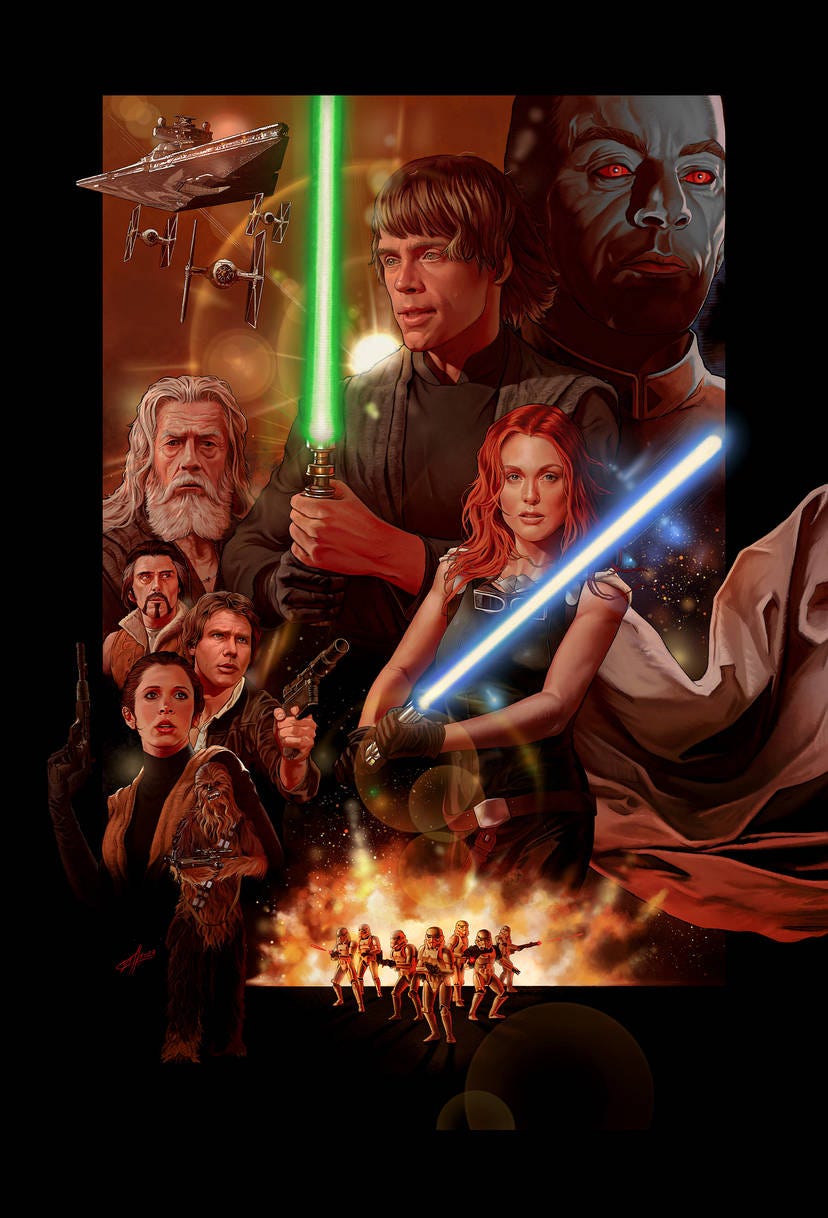
Jimmy "Mac" McInerney, host of Rebel Force Radio, recalls reading the HEIR TO THE EMPIRE trilogy this way: “I read a blurb at the time that I thought perfectly summed up the experience – ‘when you read Timothy Zahn’s words, you hear John Williams’ soundtrack.’ And I thought, that is so true.”
From his home recording studio, he tells me about his excitement at the news HEIR TO THE TRILOGY was coming out in 1991, which he discovered in the pages of the Chicago Tribune. As a student at Columbia College at the time, he was, in his words, still a closeted STAR WARS fan. “I rolled into a bookstore, and I was, like, ‘Hey’” — here his voice changes to try to sound as cool as an under-cover spy — “‘Hey, do you have HEIR TO THE EMPIRE?’ ‘What’s HEIR TO THE EMPIRE?’” The bookshop clerk had to look it up. “‘Oh, it’s the STAR WARS. Why didn’t you just say so?’”
Jimmy read the STAR WARS sequel in a week in between pizza runs as a delivery boy, often sitting on the hood of his 1978 Monte Carlo, which he says he left an ass-dent in as a result. “The Expanded Universe really does start with HEIR TO THE EMPIRE,” he says. “I mean, that’s the first legitimate, authentic push to take STAR WARS outside of the films and be real about the stories.”
The series was so successful, its impact on popular culture so significant, that some have even argued it inspired George Lucas to return to making STAR WARS films in 1999. I’m skeptical of this argument for many reasons, but hey, fun fact, when he did, he set a spectacular amount of the action on the Old Republic capital – a city-planet called Coruscant. Want to guess who dreamed up Coruscant in 1991, from its name right down to its description? Spoiler: it wasn’t him.
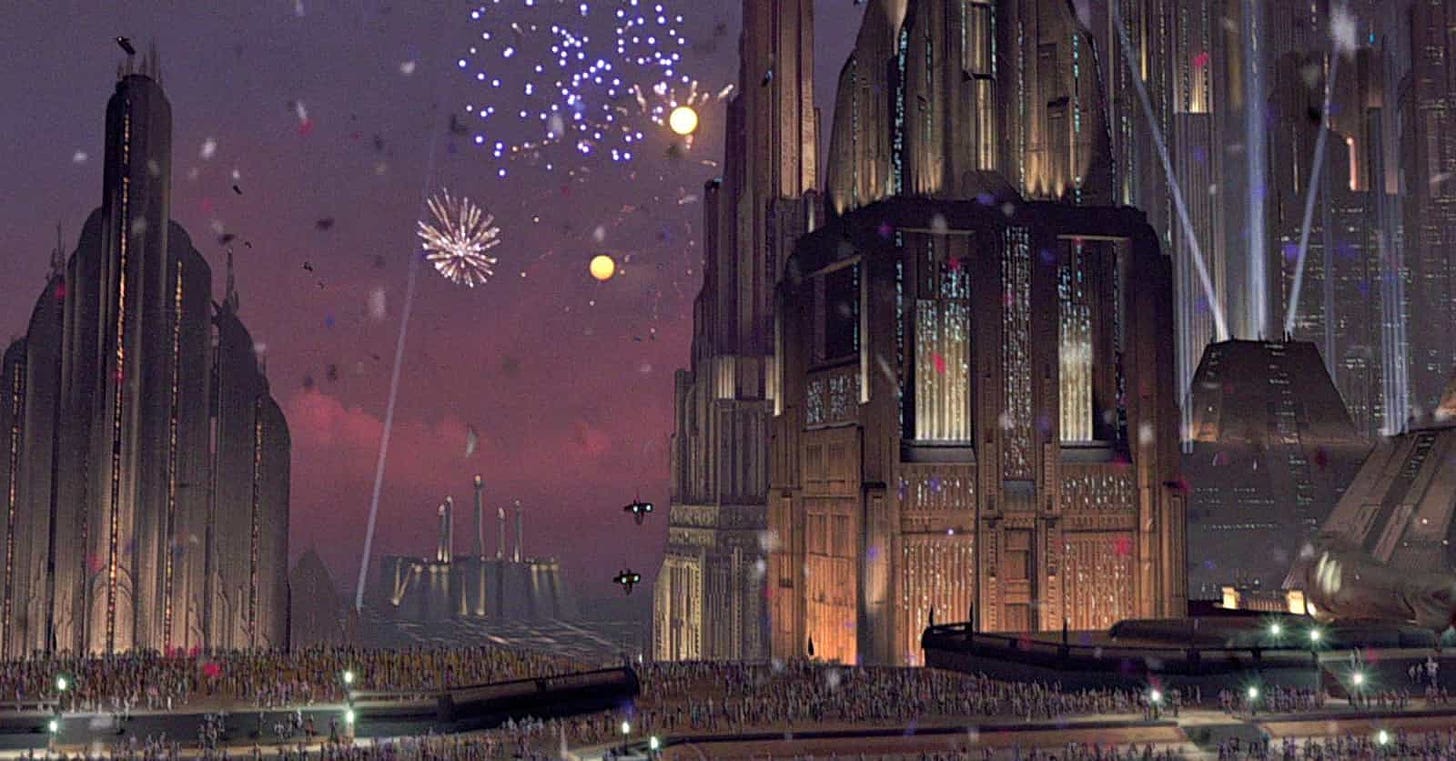
THRAWN’S RETURN
Grand Admiral Thrawn landed for the first time on our screens in 2016 in “STAR WARS REBELS”, as I already explained. Fans ate up his official entry into what we call canon today, as HEIR TO THE EMPIRE and the rest of the Expanded Universe was relegated to “Legends” status when Disney bought Lucasfilm - a sore subject for many diehard STAR WARS fans to this day.
Zahn has contemplated Thrawn’s popularity on many occasions. He told Verge back in 20173:
I think it’s because he was so different from any other villain we’d seen in Star Wars to that time. Most Imperials seemed to follow the ‘hit it with a rock’ school of thought regarding opposition. Thrawn, in contrast, used strategy and careful planning and usually managed to be two or three steps ahead of the New Republic. Readers like their villains to be a challenge to the heroes because that forces the heroes to bring their best game to the field. The more clever the opponent, and the more difficult the fight, the more satisfying the victory.
But I can’t help but wonder what it must be like to have created such an iconic character and then watch others handle his elevation to television star. Zahn has discussed this, too:
I was invited to LFL [Lucasfilm Limited] in mid-November 2015 with the vague reason that they wanted to “chat about STAR WARS.” There were hints that this was going to be something important, but I had no idea what was going on until everyone was assembled in the conference room and Dave [Filoni] dropped the news on me. Needless to say, I was floored. They then showed me the clip of Thrawn’s first appearance and I got a tour of the “REBEL’s” bullpen and a chance to meet all the terrific people who work on the show.
When asked about whether Filoni and Lucasfilm integrated Zahn into the process at all, Zahn offered this reply:
I didn’t have any real input into how Thrawn was going to be handled, mainly because the lead time of an animated series is so long that much of Season 3 had already been finished.
In other words, Zahn was an afterthought, only told about Thrawn after work on his creation was almost complete. So, why did Lucasfilm bring him in anyway?
After my tour of the “REBELS” work area, I was taken back upstairs and a handful of us sat down and discussed the new book they wanted me to write. Since the novel would be a prequel to Thrawn’s appearance in the show, there wouldn’t be any overlap to worry about. All I really had to do was gather whatever information they could give me about Thrawn’s Season 3 story arc and look for places I could foreshadow events of the series in Thrawn’s earlier experiences.
I want to be careful with what I say next because I don’t want to assume anything about what happened here or how Zahn felt about it. But it’s very hard for me to read all this and not get the sense that Lucasfilm essentially — and very legally — lifted Zahn’s work from the HEIR TO THE EMPIRE trilogy, repurposed it for “REBELS”, and then asked the guy responsible for creating the character and saving the whole brand a long, long time ago to come in and legitimize what they had done by stamping his name on the (again) legal but still creative theft.
Thrawn’s elevation to the Big Bad of the “MANDALORIAN” universe, set up over two seasons of “MANDALORIAN” and now taking center stage in “AHSOKA” and an upcoming film written and directed by Filoni — that I would bet a lot of money on actually being called HEIR TO THE EMPIRE — continues to leave a gross taste in my mouth. Even more so after I read how Zahn described finding out about this on his Facebook page when fans asked him why he hadn’t shared the news earlier.4
No, I was not holding back on you (or anyone else). I was (and am) completely out of the loop on all things Mandalorian. The first I heard about Ahsoka's name-dropping question was when people began peppering this page with comments, questions, and verbal high-fives.
The guy found out on social media.
Social. Fucking. Media.
It gets worse when I listen to Zahn talk about his part in it all, which often feels like he’s waving his hand at Filoni and Lucasfilm, shouting, “Remember me? I did that for you.” Consider what the author said during 2023’s STAR WARS Celebration: “And I am, of course, available to help them if needed. We only talked briefly about all this.”5
If needed.
Talked briefly.
Oof.
Kyle Newman is concerned by this, too. “These people are, like, ‘Hey, these books that you [the fans] read and spent all this money on for thirty years — you know, everything this whole expanded universe that we're just pillaging — we're not going to acknowledge it, but we can take whatever we want from it…yeah, that's problematic.”
Jimmy McInerney takes a more pragmatic approach when I ask him about all this. He points out that Zahn has always said in interviews and on stage that STAR WARS is — or, these days, was — George Lucas’s world. If Lucas wanted to tell his own stories that negated Zahn’s, then the author was fine with it. “He signed on to a pre-existing IP. And in that situation, I believe these creatives do give up individual ownership of the things they're creating in the name of the IP. It's not about them anymore. It's about the machine. They get paid for what they do.”
“Maybe he doesn't want to have anything to do with it,” the STAR WARS podcast host added, “or maybe he does and the stuff he's been pitching blows. Maybe he needs to stay in his lane - which is novels, science fiction.”
I appreciate McInerney’s dispassionate thoughts on the matter, but I want to point out that comic-book artists have long worked “for hire”, similarly writing and creating characters for the major comic book publishers they do not retain ownership rights to. After decades of creators being cheated out of both credit and profit participation, often left with no recourse other than the courts, we now refuse to accept this as the norm anymore and expect — at a minimum — for creators’ names to show up on our screens.
The parallel extends well beyond work-for-hire credit or earnings. Comic books used to only really exist on the page, as much of the Expanded Universe once did. But as the 21st century has progressed, both comic books and STAR WARS have become standard fixtures on our screens. This wasn’t part of the original deal creators struck with their employers. For example, writer Ed Brubaker’s character the Winter Soldier was created for comic books. When Marvel became a studio and sought to exploit that character in a different format, Brubaker expected appropriate compensation and eventually settled with Marvel to get him that.6
In Zahn’s case, he — like many other authors and comic book writers — created characters and worlds for the page as work for hire that is now being adapted for the screen. What was once adaptation is being reverse-engineered into, as I said, canon. Lucasfilm — and Disney — are significantly cashing in on these creations without further remunerating the artists behind them or, as important, crediting them on screen. It may be legally right, sure, but it’s still an incredibly fucked up thing to do.
ALL THE WAYS STAR WARS HAS BUILT ITS FILM/TV BRAND ON OTHER PEOPLE’S CREATIONS
Here is a short list of all the Expanded Universe characters, worlds, and storylines created by artists for novels, comic books, and roleplaying and video games that have shown up in STAR WARS films and TV series. The filmmakers who were “inspired” by it received compensation for their stories at levels most typically well beyond what the creators themselves ever received for their work.
Coruscant: Created and named by Timothy Zahn in HEIR TO THE EMPIRE. First appears on screen in STAR WARS: RETURN OF THE JEDI’s Special Edition.
The New Republic: Zahn, HEIR TO THE EMPIRE. First manifests onscreen in the STAR WARS in the Sequel Trilogy and is now a central feature of the Mando-verse.
Grand Admiral Thrawn: Zahn, HEIR TO THE EMPIRE. First onscreen appearance, “STAR WARS REBELS”.
Rukh and the Noghri species: Zahn, HEIR TO THE EMPIRE. First onscreen appearance, “STAR WARS REBELS”.
Captain Pallaeon: Zahn, HEIR TO THE EMPIRE. First onscreen appearance, “THE MANDALORIAN”.
Cloning Jedi: Zahn, HEIR TO THE EMPIRE - not “THE MANDALORIAN”.
Mount Tantiss and the Weyland facility: Are you watching “STAR WARS: THE BAD BATCH”? If so, you know Mount Tantiss was where the Emperor moved Kamino’s cloning program here after REVENGE OF THE SITH. Both originated in Zahn’s HEIR TO THE EMPIRE.
Jacen Syndullah: The son of Hera Syndullah and Jedi Kanan Jarrus was introduced to the world at the conclusion of “STAR WARS REBELS”, but his name bears some interrogation. Because Jacen was the name given to one of Han and Leia’s twin children at the conclusion of the HEIR TO THE EMPIRE trilogy.
The Imperial Inquisitors: Dig these in “STAR WARS REBELS”? Yeah, they were originally dreamed up by West End Games in the nineties.
Dark Troopers: They were pretty damn cool in “THE MANDALORIAN”. They were in the video game “STAR WARS: DARK FORCES” released in 1995, too.
Beskar (Mandalorian steel): Not “THE MANDALORIAN”. It was first referenced in a 2006 Star Wars Insider article called “THE MANDALORIANS: PEOPLE AND CULTURE” written by Karen Traviss.
Aayla Secura: You might remember this striking blue-skinned Twi’lek Jedi from STAR WARS: ATTACK OF THE CLONES and REVENGE OF THE SITH (where she perished in Order 66), but her first appearance was in a 2000 Dark Horse comic. She was created by Jon Ostrander and Jan Duursema; these two are giants of the so-called Legends era.
Quinlan Vos: Jedi Master Vos got name-checked in “STAR WARS: REVENGE OF THE SITH” and later made his onscreen debut in “STAR WARS: THE CLONE WARS. He was even hinted at in “OBI-WAN KENOBI”. But he was created by Jon Ostrander and Jan Duursema for Dark Horse Comics where he fought alongside his padawan Aayla Secura.
The Witches of Dathomir: This culture of Force-wielding witches an their planet of Dathomir played a huge part in “STAR WARS: THE CLONE WARS”, were retconned as part of the origin of Darth Maul, and most recently seen the character of Morgan Elsbeth in “AHSOKA” connected to them…but sorry, the real creator of this corner of STAR WARS’ mythology is Dave Wolverton, the author of the novel THE COURTSHIP OF PRINCESS LEIA (1994).
Riding rancors: Speaking of THE COURTSHIP OF PRINCESS LEIA, if you dug watching Boba Fett ride a giant rancor in “THE BOOK OF BOBA FETT”, it was Dave Wolverton who also dreamed a kick-ass sight like that up.
The Maelstrom: In SOLO: A STAR WARS STORY, Han must fly through a black hole cluster around Kessel. This first appeared in Kevin J. Anderson’s Jedi Academy trilogy, where it was called the Maw.
Ben Solo turning to the Dark Side: In STAR WARS: THE FORCE AWAKENS’ Han and Leia’s son turns to the Dark Side. He does in the Legacy of the Force book series first.
Force projection: In STAR WARS: THE LAST JEDI, Luke Skywalker uses this skill during his climactic confrontation with Kylo Ren. But this ability was first used in Dark Horse Comics’ DARK EMPIRE series in 1992 - written by Tom Veitch and illustrated (quite stunningly) by Cam Kennedy. Veitch, it should be noted, is another giant of the Legends era.
Boba Fett escapes the sarlacc: Yeah, he did it in “THE BOOK OF BOBA FETT”. But he did it first in DARK EMPIRE.
The Emperor’s return: Emperor Palpatine was resurrected as a clone in STAR WARS: THE RISE OF SKYWALKER, but this storyline first played out in DARK EMPIRE, too.
This is just the tip of a really big damn iceberg, I should note. There are so many other names who have significantly contributed to STAR WARS canon but receive no acknowledgment for their work today beyond references on sites like Wookipedia. Amongst them, otherwise not mentioned here, are Michael A. Stackpole, Aaron Allston, Drew Karpyshyn, Kathy Tyers, R.A. Salvatore, and so many others. For legions of STAR WARS fans in the nineties and aughts, all these authors and comic book writers were all heroes.
SAY HIS NAME
There is no confusion here. Lucasfilm is legally exploiting intellectual property to which it owns all the rights. Dave Filoni and the other filmmakers who take advantage of this deep well of story are technically doing nothing wrong. But I want to suggest it’s still morally wrong and it needs to change. Artists should be fairly compensated for the work they generate. Art created for one medium should not be adaptable in others without additional compensation and, more, appropriate attribution.
Further, when you base substantial elements of a new story or series of stories on an earlier one, there is also a moral obligation to regularly and vociferously credit the originator of those elements. Someone like Timothy Zahn should not discover their work is being yet again used in new and ever more profitable ways via social media. He should be invited to sit on panels when his work’s adaptation is discussed. He should be celebrated on red carpets. And one certainly shouldn’t be able to Google Zahn’s name alongside the name of the guy who’s loosely adapting his work across multiple TV series and films and discover there’s only one instance on the internet of the two of them existing at the same place at the same time - this being photos from a reveal of a Grand Admiral Thrawn action figure.
Everything I’ve described here doesn’t really shock in 2023, especially as we’re in the midst of two strikes against studios and streamers for numerous abuses and a general refusal to fairly pay the artists they employ - including Disney, the parent company of Lucasfilm.
In fact, it’s right on brand for corporations as a whole that have argued screenwriters should just be grateful they have jobs at all and privately plotted to cost these same writers’ their homes just to teach them a lesson for expecting more.7
This is all part of the same conversation, if you haven’t caught on yet: decimating screenwriters’ ability to live to justify another multi-million-dollar bonus, scheming to replace actors with A.I., reaping hundreds of millions of dollars off comic book creators’ work you paid relative pennies for, and, of course, treating a back catalog of artists’ work like a free all-you-can-eat buffet to gorge yourself on.
Which is why it’s time for Lucasfilm to pay Timothy Zahn more than just lip service for his creations.
It’s time to say his name regularly and vociferously.
It’s time to say all of the names of the artists who have made STAR WARS what it is today.
If this article added anything to your life but you’re not up for a paid subscription, please consider buying me a “coffee” so I can keep as much of this newsletter free as possible for the dreamers who couldn’t afford it otherwise.
My debut novel PSALMS FOR THE END OF THE WORLD is out now from Headline Books, Hachette Australia, and more. You can order it here wherever you are in the world:
https://variety.com/2023/film/news/star-wars-movies-dave-filoni-james-mangold-1235576542/
https://web.archive.org/web/20100521142100/http://www.zoklet.net/totse/en/ego/science_fiction/tzi.html
https://www.theverge.com/2017/4/27/15434984/star-wars-timothy-zahn-interview-grand-admiral-thrawn-rebels-books
https://www.facebook.com/TimothyZahn/posts/222331769253716?ref=embed_post
https://thedirect.com/article/star-wars-thrawn-villain-live-action-debut
https://www.slashfilm.com/582617/superhero-comic-credits-creators/
https://deadline.com/2023/07/writers-strike-hollywood-studios-deal-fight-wga-actors-1235434335/




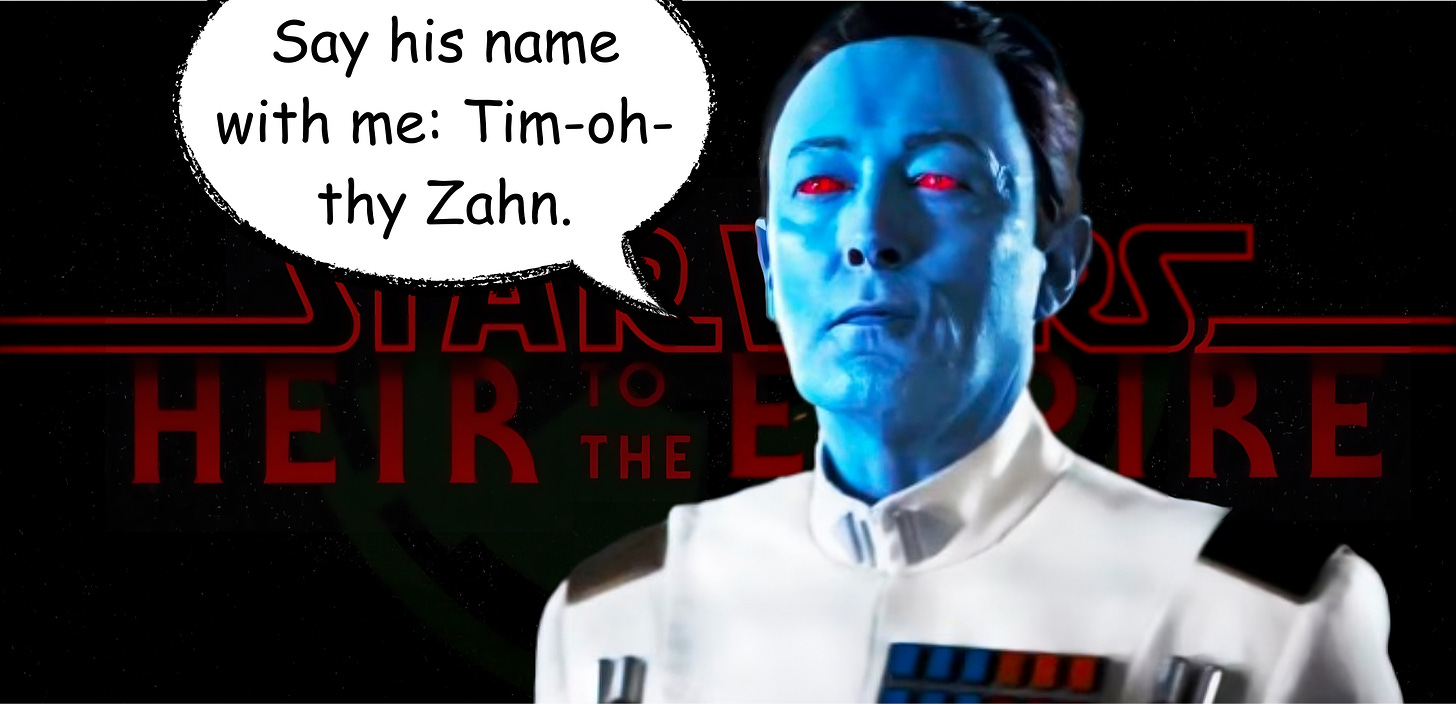
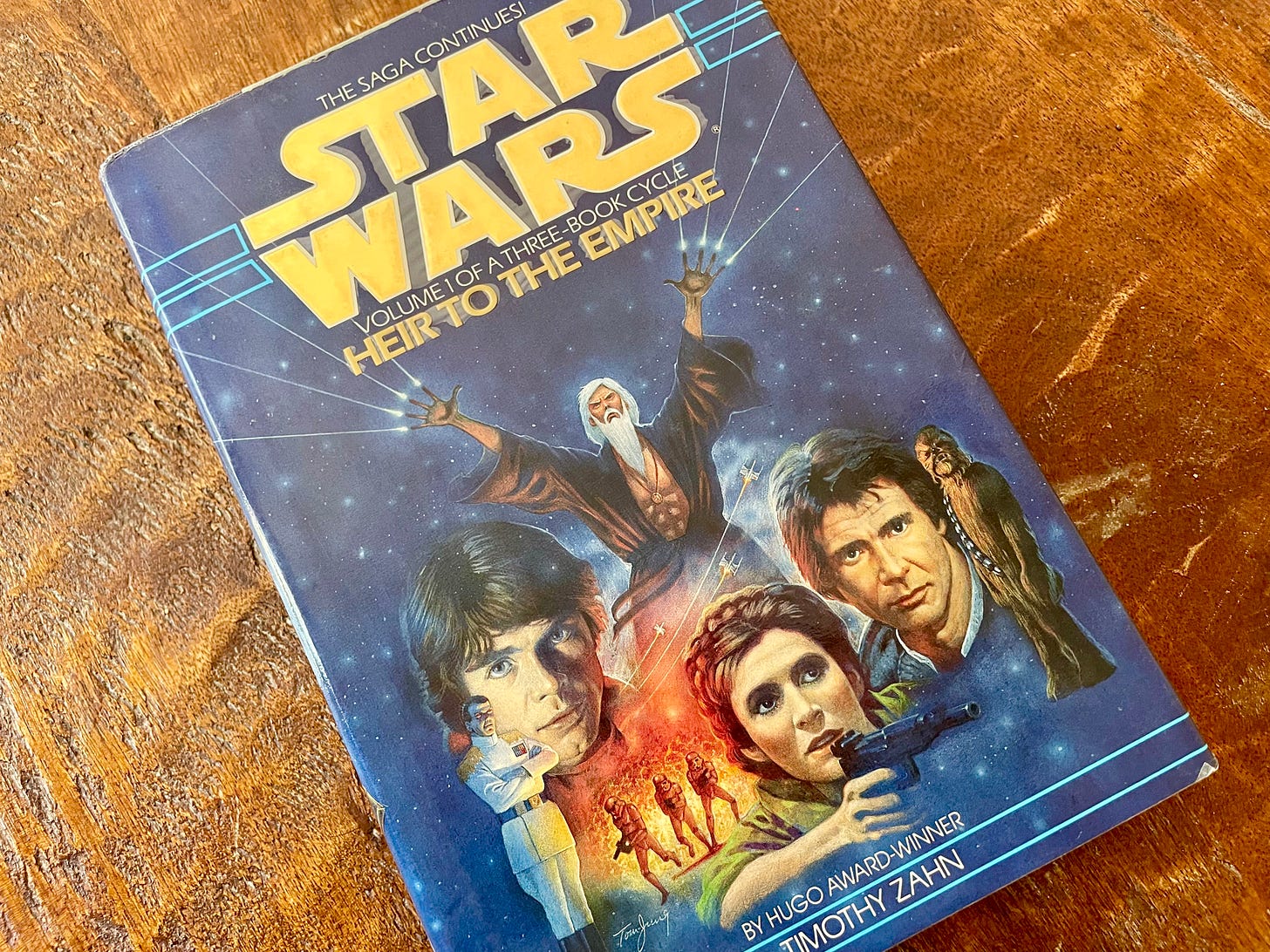
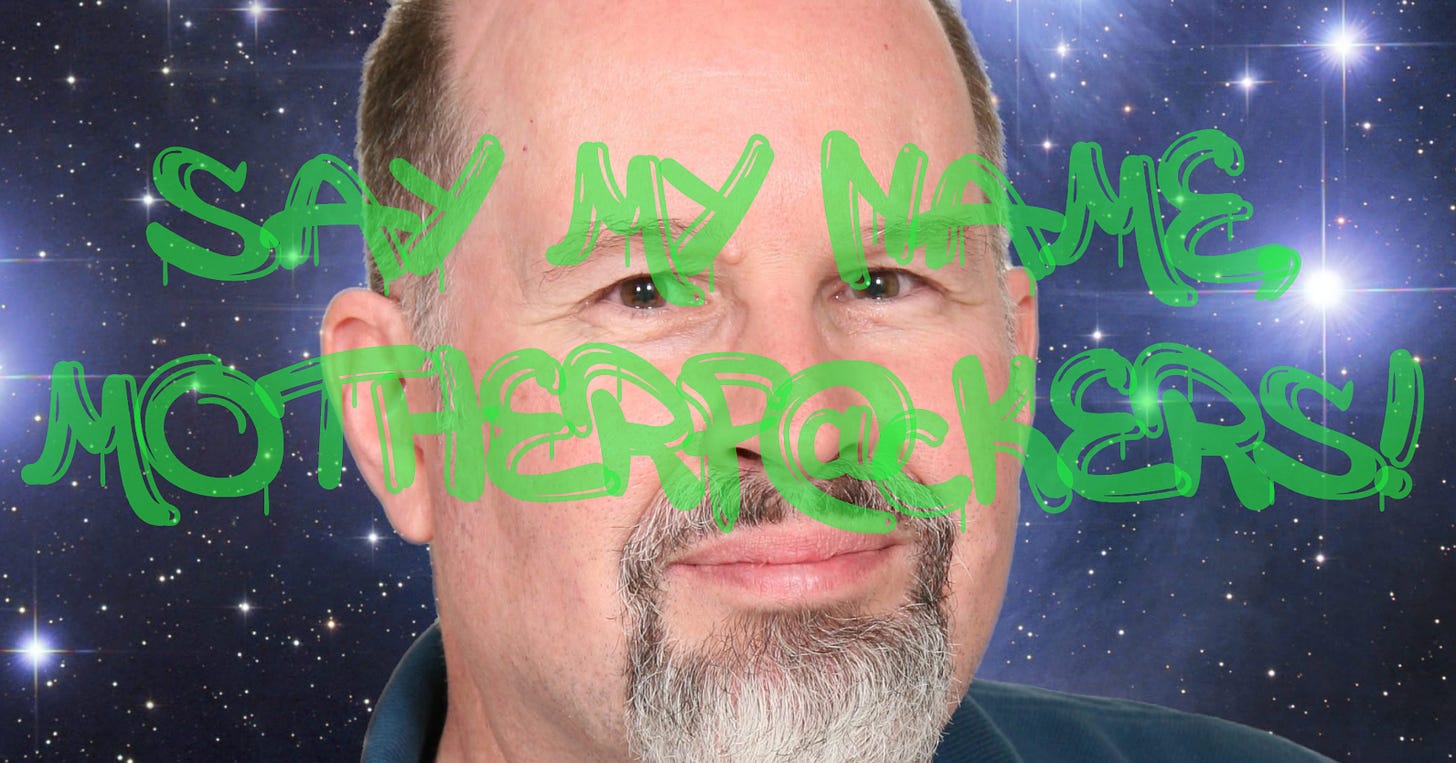
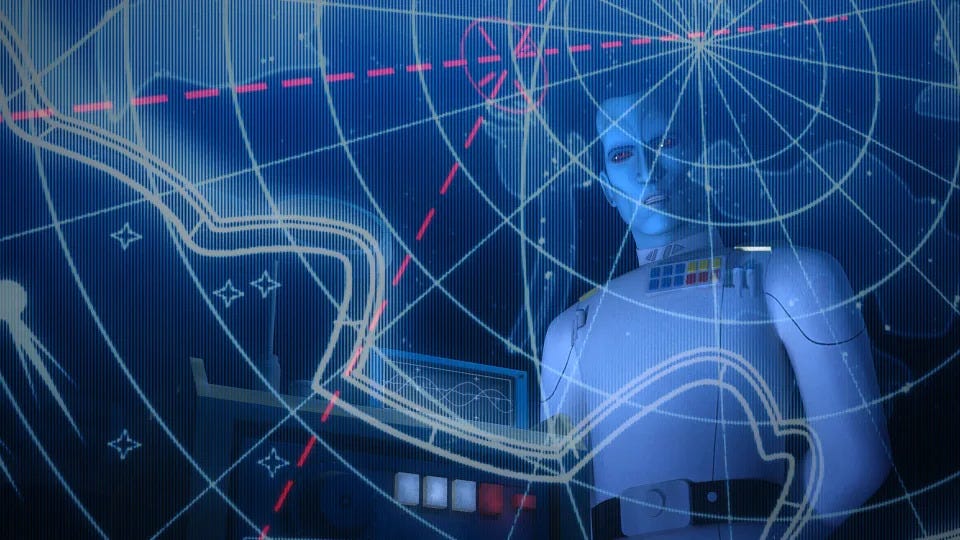
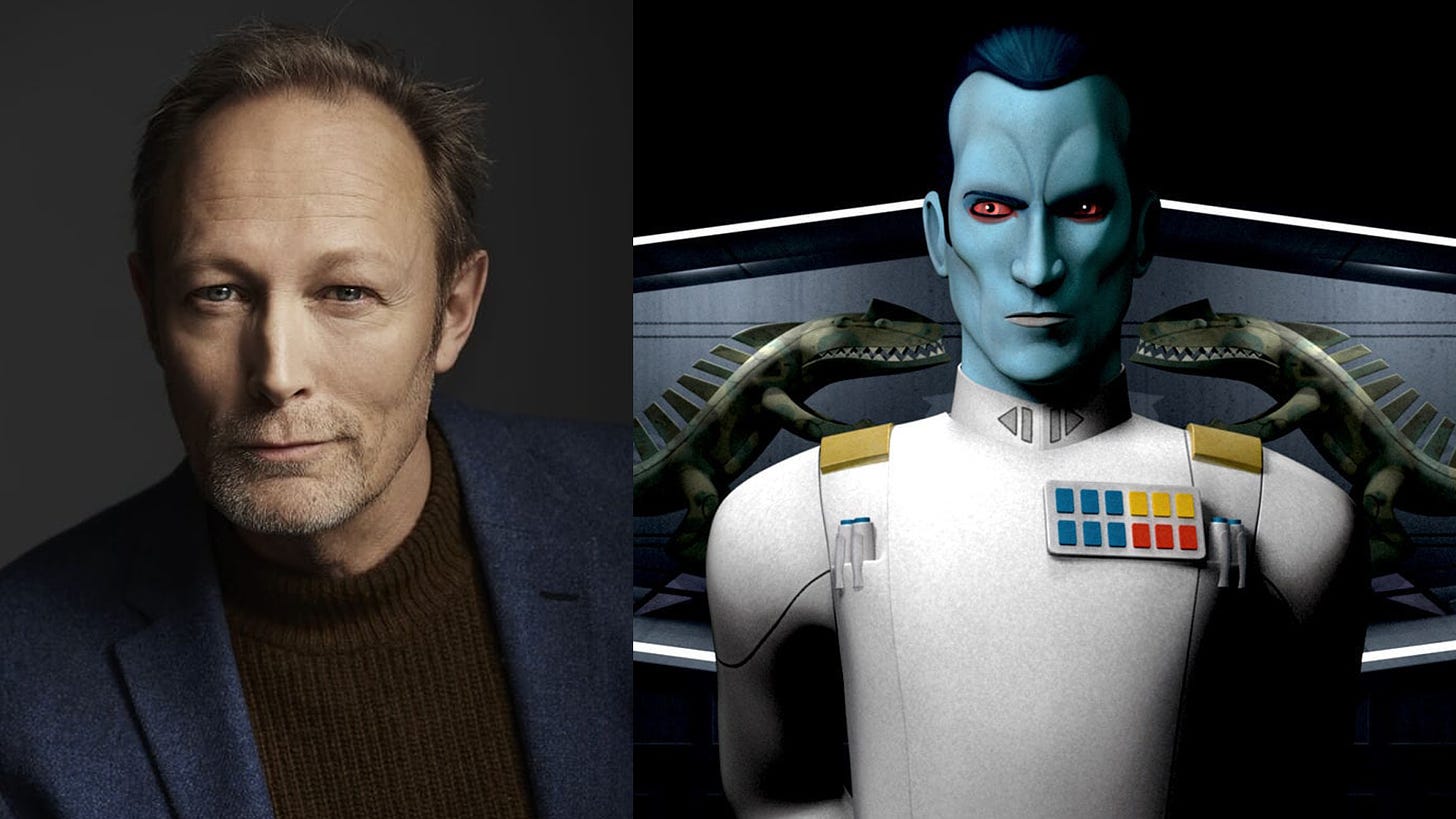
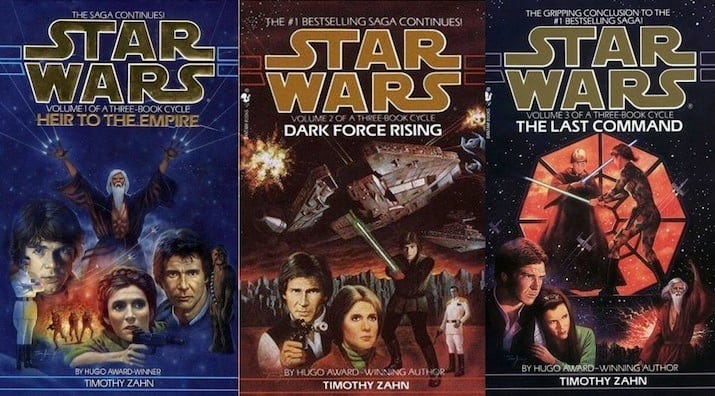
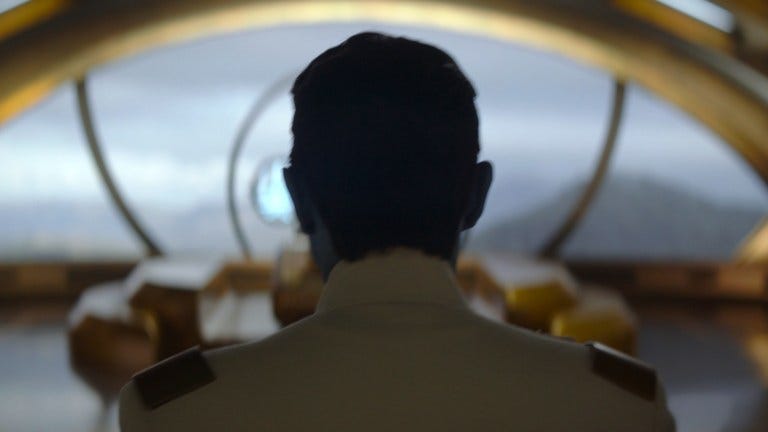
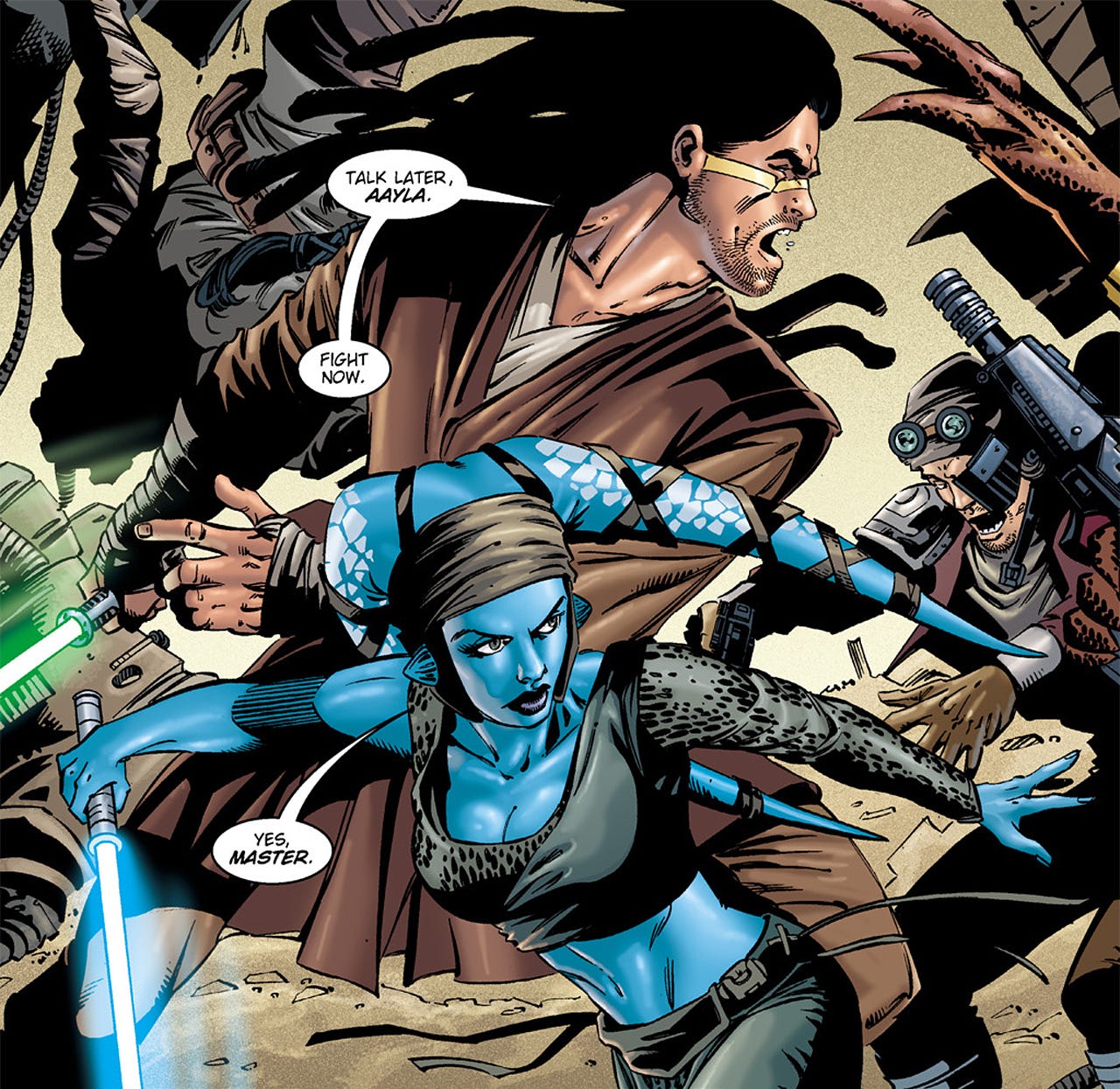
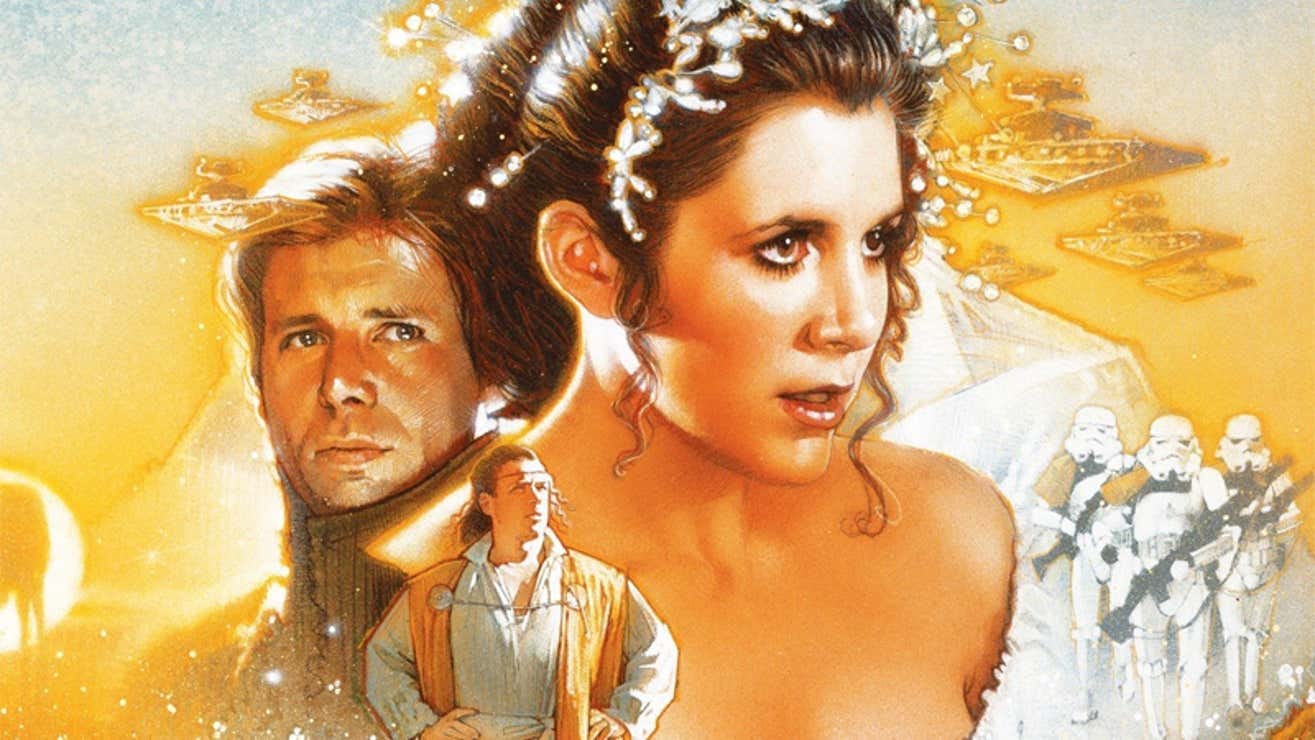
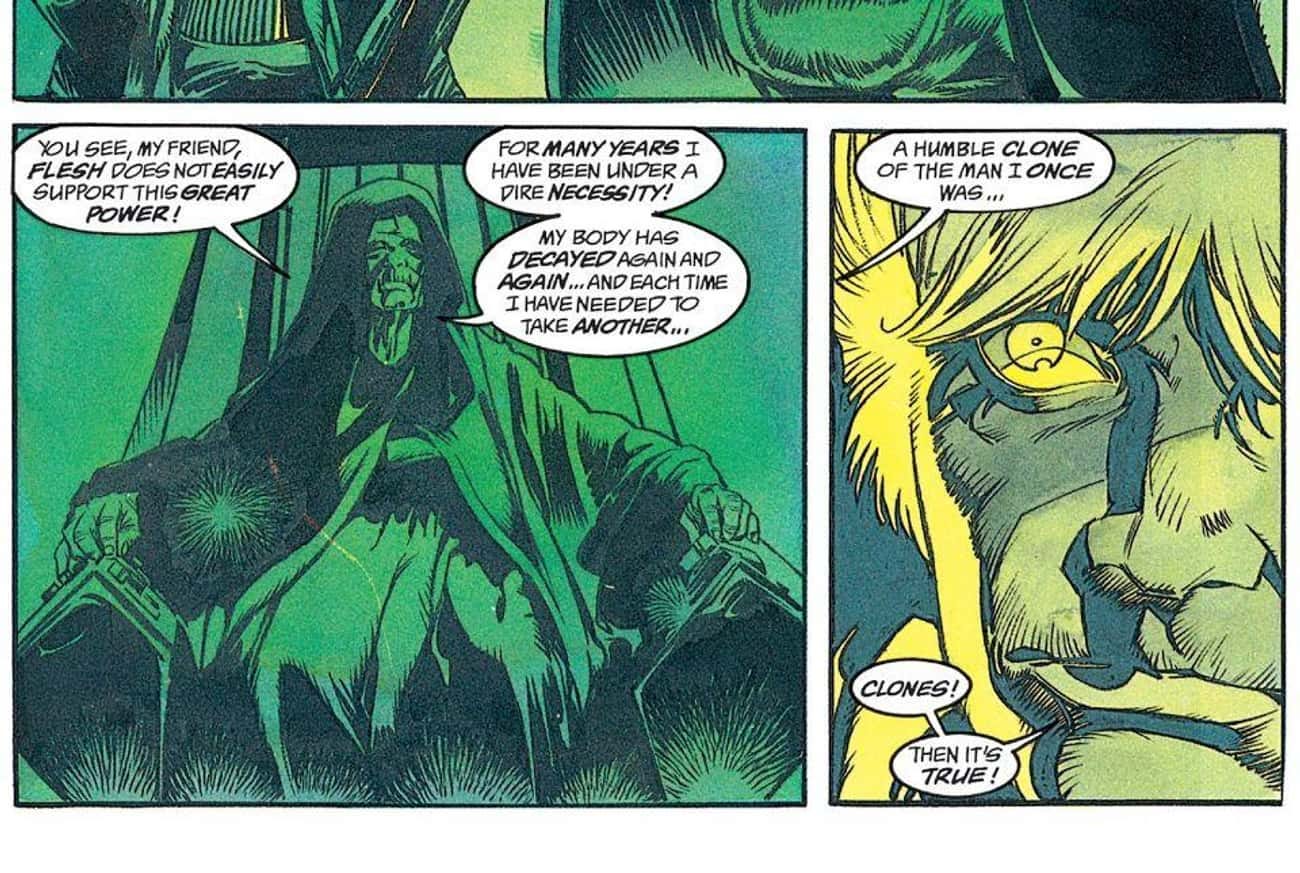
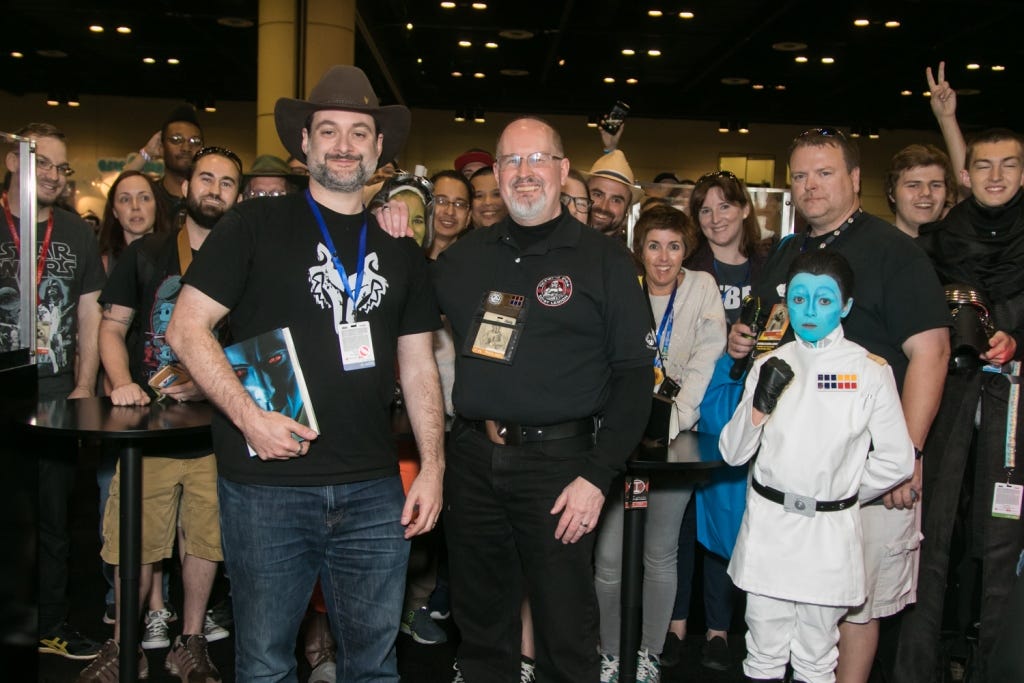

Interesting bit to list all the contributors who live in the shadows and then compare it to the abuse in comic books. Also, Hate to be one to slander another filmmaker, yet, outside of Andor, it’s all been pretty forgettable post the Prequel Trilogy, mainly, it seems due to the strip mining of work from creators who aren’t involved in the live-action adaptations.
What an amazing and complete article, Cole. Anyway, this has little to do with the article but I loved Fanboys!